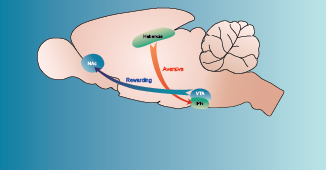Featured
In This Section
Keep up to date on research advances in the prevention and treatment of drug abuse and AIDS with NIDA’s newsletter NIDA Notes.
Featured Articles
-
Sublingual buprenorphine is a safe and effective alternative to methadone for treating opioid dependence during pregnancy, finds the Maternal Opioid Treatment: Human Experimental Research (MOTHER) study, a NIDA-supported clinical trial. Women who received either medication had similar pregnancy and birth outcomes, but infants born to women who received buprenorphine had milder symptoms of neonatal opioid withdrawal.
-
While viewing images of cigarettes, smokers reported milder cravings when they shifted their focus from the pleasures of smoking to its harmful effects. Brain imaging showed a correlation between the reductions in craving and altered activity levels in regions associated with emotional regulation and reward.
Updates
-
Fewer than 12 percent of adolescents who meet diagnostic criteria for prescription opioid abuse or dependence receive any treatment, according to an analysis of data from the 2005 to 2008 National Survey on Drug Use and Health. The most common reason the adolescents gave for not receiving treatment was their lack of perceived need for it.
Director's Perspective
-
NIDA researchers have developed a computer program that motivates and encourages treatment-seeking when an individual is in a primary care physician’s waiting room. Users of the program, called Video Doctor, enter information on a portable device and receive feedback about health risks related to their drug abuse, along with advice, immediately prior to seeing their physician.
Graphic Evidence
-
Ninety percent of privately funded substance abuse treatment programs in the United States offer cognitive behavioral therapy (CBT)...
NIDA at Work
-
NIDA’s Women and Sex/Gender Differences Research Program focuses on gender-specific addiction risk factors and treatment needs.
Bulletin Board
-
NIDA researchers working with human subjects now have a new resource at their fingertips: the PhenX Toolkit’s new Substance Abuse and Addiction (SAA) Collection. The Toolkit is designed to provide standardized measures, vetted and approved by the field, to help researchers compare and combine data from multiple studies.
 External link, please review our disclaimer.
External link, please review our disclaimer.  External link, please review our disclaimer.
External link, please review our disclaimer.  External link, please review our disclaimer.
External link, please review our disclaimer.  External link, please review our disclaimer.External link, please review our disclaimer.
External link, please review our disclaimer.External link, please review our disclaimer. 









